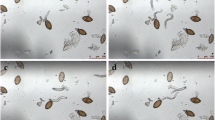Abstract
Murine immunological responses to experimental infection with Trichuris muris and the effects of the resident microbiota on these responses are of increasing interest. For these studies, accurate dose delivery and improved sterilization of inocula are essential to prevent co-infection with unknown contaminants. We found that washing T. muris eggs with antibiotics may not be sufficient for sterilization of inocula. However, washing eggs in 6.25% hypochlorite/bleach eliminated bacteria and fungi, as determined by culture and PCR, did not harm viable T. muris eggs and reduced the number of non-viable eggs in the inocula. A hatching assay and propidium iodide staining method were developed and found to increase the accuracy for assessing T. muris egg viability prior to infection for rapid dose evaluation. In addition, metal gavage feeding needles increased the accuracy and precision of the dose delivered to the mice compared to flexible rubber tubes. These methods will improve experimental Trichuris studies by decreasing the variability in outcome due to unintended carryover of adherent microorganisms and unrecognized variation in inocula.





Similar content being viewed by others
References
Abner SR, Parthasarathy G, Hill DE, Mansfield LS (2001) Trichuris suis: detection of antibacterial activity in excretory–secretory products from adults. Exp Parasitol 99:26–36
Abner SR, Hill DE, Turner JR, Black ED, Bartlett P, Urban JF, Mansfield LS (2002) Response of intestinal epithelial cells to Trichuris suis excretory–secretory products and the influence on Campylobacter jejuni invasion under in vitro conditions. J Parasitol 88:738–745
Black MI, Scarpino PV, O'Donnell CJ, Meyer KB, Jones JV, Kaneshiro ES (1982) Survival rates of parasite eggs in sludge during aerobic and anaerobic digestion. Appl Environ Microbiol 44:1138–1143
Else KJ, deSchoolmeester ML (2003) Immunity to Trichuris muris in the laboratory mouse. J Helminthol 77:95–98
Elsheikha HM, Mansfield LS (2004) Assessment of Sarcocystis neurona sporocyst viability and differentiation between viable and nonviable sporocysts using propidium iodide stain. J Parasitol 90:872–875
Fernandez M, Sanchez J (2002) Nuclease activities and cell death processes associated with the development of surface cultures of Streptomyces antibioticus ETH 7451. Microbiology 148:405–412
Kotze AC, Coleman GT, Mai A, McCarthy JS (2005) Field evaluation of anthelmintic drug sensitivity using in vitro egg hatch and larval motility assays with Necator americanus recovered from human clinical isolates. Int J Parasitol 35:445–453
Mansfield LS, Urban JF (1996) The pathogenesis of necrotic proliferative colitis in swine is linked to whipworm induced suppression of mucosal immunity to resident bacteria. Vet Immunol Immunopathol 50:1–17
Mansfield LS, Gauthier DT, Abner SR, Jones KM, Wilder SR, Urban JF (2003) Enhancement of disease and pathology by synergy of Trichuris suis and Campylobacter jejuni in the colon of immunologically naive swine. Am J Trop Med Hyg 68:70–80
Mansfield LS, Bell JA, Wilson DL, Murphy AJ, Elsheikha HM, Rathinam VA, Fierro BR, Linz JE, Young VB (2007) C57BL/6 and congenic interleukin-10-deficient mice can serve as models of Campylobacter jejuni colonization and enteritis. Infect Immun 75:1099–1115
Mines JJ (1977) Modifications of the McMaster worm egg counting method. Aust Vet J 53:342–343
Nagashima K, Hisada T, Sato M, Mochizuki J (2003) Application of new primer-enzyme combinations to terminal restriction fragment length polymorphism profiling of bacterial populations in human feces. Appl Environ Microbiol 69:1251–1262
Panka DJ, Mier JW (2003) Canstatin inhibits Akt activation and induces Fas-dependent apoptosis in endothelial cells. J Biol Chem 278:37632–37636
Schopf LR, Hoffmann KF, Cheever AW, Urban JF, Wynn TA (2002) IL-10 is critical for host resistance and survival during gastrointestinal helminth infection. J Immunol 168:2383–2392
Stephenson LS, Holland CV, Cooper ES (2000) The public health significance of Trichuris trichiura. Parasitology 121(Suppl):S73–S95
Summers RW, Elliott DE, Qadir K, Urban JF Jr, Thompson R, Weinstock JV (2003) Trichuris suis seems to be safe and possibly effective in the treatment of inflammatory bowel disease. Am J Gastroenterol 98:2034–2041
Tilney LG, Connelly PS, Guild GM, Vranich KA, Artis D (2005) Adaptation of a nematode parasite to living within the mammalian epithelium. J Exp Zool A Comp Exp Biol 303:927–945
Veldhoen M, Uyttenhove C, van Snick J, Helmby H, Westendorf A, Buer J, Martin B, Wilhelm C, Stockinger B (2008) Transforming growth factor-beta 'reprograms' the differentiation of T helper 2 cells and promotes an interleukin 9-producing subset. Nat Immunol 9:1341–1346
Wharton DA, Jenkins T (1978) Structure and chemistry of the egg-shell of a nematode (Trichuris suis). Tissue Cell 10:427–440
Williams ME, Montenegro S, Domingues AL, Wynn TA, Teixeira K, Mahanty S, Coutinho A, Sher A (1994) Leukocytes of patients with Schistosoma mansoni respond with a Th2 pattern of cytokine production to mitogen or egg antigens but with a Th0 pattern to worm antigens. J Infect Dis 170:946–954
Zaph C, Rook KA, Goldschmidt M, Mohrs M, Scott P, Artis D (2006) Persistence and function of central and effector memory CD4+ T cells following infection with a gastrointestinal helminth. J Immunol 177:511–518
Acknowledgements
We thank Dr. Julia Bell for the help with the statistical methods and for the review of the manuscript. The project was funded in whole with federal funds from the NCRR, NIH, and the Department of Health and Human Services under grant no. 5K26RR023080. Some of the mice were produced with federal funds from the NIAID, NIH, and the Department of Health and Human Services under contract no. N01-AI-30058.
Author information
Authors and Affiliations
Corresponding author
Rights and permissions
About this article
Cite this article
Kopper, J.J., Mansfield, L.S. Development of improved methods for delivery of Trichuris muris to the laboratory mouse. Parasitol Res 107, 1103–1113 (2010). https://doi.org/10.1007/s00436-010-1978-8
Received:
Accepted:
Published:
Issue Date:
DOI: https://doi.org/10.1007/s00436-010-1978-8




